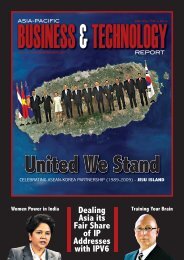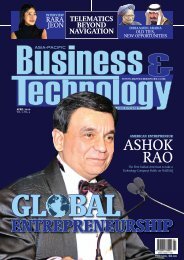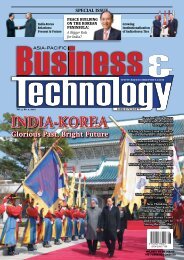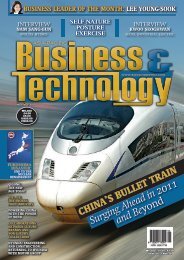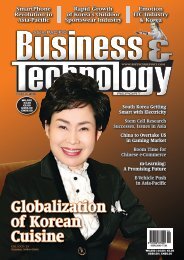GreeN Growth - Asia-Pacific Business and Technology Report
GreeN Growth - Asia-Pacific Business and Technology Report
GreeN Growth - Asia-Pacific Business and Technology Report
- No tags were found...
You also want an ePaper? Increase the reach of your titles
YUMPU automatically turns print PDFs into web optimized ePapers that Google loves.
technologywww.biztechreport.comFastest Wireless TransmissionCircuit <strong>Technology</strong> Developingin JapanBy Anuradha ShuklaImagine wireless datastreaming to your laptopat speeds faster that whatyour current wired localarea networks are capableof.That would be a real treat, as you wouldbe able to enjoy hours of streaming highdefinitionvideo via your WiFi connectionat a quality you’d never experienced before.Again, imagine having that kind of speed,which people are now calling Wireless Gibabit(WiGig), directly on your mobile devices.This may soon become a reality with announcementsfrom Panasonic about creatinga WiGig-capable chip that is designedspecifically for the mobile phone. The WirelessGigabit Alliance, the main driver forWiGig technologies, has been collaboratingwith Panasonic on the development of thischip, which will be capable of deliveringhigh-speed communication at speeds thatare 20 times faster than what people arecurrently used to with existing WiFi connections.60GHz Multi-gigabit WirelessCommunication <strong>Technology</strong>At present, high-speed wireless communicationfor mobile devices exists only inthe 2.4 GHz <strong>and</strong> the 5 GHz b<strong>and</strong>. Mobile devicescannot take part in higher frequencyb<strong>and</strong>widths such as at 60 GHz, the ultrahigh-speedwireless communications usedfor digital TVs, due to the high energy consumptionrequired to operate at such speedBy sun bangThe Korean technology industrywas perceived as an imitatora decade ago, but it hasrecently moved firmly into therealm of industry leadership asan Internet-enabled innovator.Samsung dominates the globalmarket in memory chips <strong>and</strong>flat-screen televisions, while LG isthe world’s top producer of airconditioners.Strauski | Dreamstime.com<strong>and</strong> b<strong>and</strong>width.But with the development of Panasonic’snew WiGig-capable chip, 60 GHz multigigabitwireless communications can nowbe optimized <strong>and</strong> used for mobile devices.Both the transceiver core <strong>and</strong> peripheralcircuits of mobile devices that will use suchtechnologies will be optimized to operateon 1W of power, making ultra-high-speedwireless communications at the 60 GHz frequencyb<strong>and</strong> a reality.For mobile users, communication speedswill be higher than existing local area networks<strong>and</strong> will operate 20 times faster thannormal. With a bigger b<strong>and</strong>width, a 30-minutevideo recorded <strong>and</strong> compressed at highdefinition will be able to be downloaded directlyto your mobile phone in ten secondsflat. High-speed high-definition video contentstreaming will also soon be stress-free.The New Evolution in WiFiThe development of the new technologywas supported by Japan’s Ministry of InternalAffairs <strong>and</strong> Communications as part ofits research <strong>and</strong> development project forthe expansion of radio spectrum resources.The development was also a major endeavorof the Wireless Gigabit (WiGig) Alliance,where Panasonic sits as a board member.The Wireless Gigabit Alliance, composedof technology leaders in the personal computer,electronics, semiconductor, <strong>and</strong> mobilephone industries, is the main driver ofdeveloping faster wireless connectivity thatwill be the next evolution of WiFi used forcommunications, computing <strong>and</strong> entertainment.It will take a little more time before ahigh-end smart phone sporting the new 60GHz chip from Panasonic will be introducedinto the market. The company is still workingon the product design <strong>and</strong> architecturethat will draw in less than 1W of power. Butwhen it does emerge, expect people to gogaga over their mobile phones, downloadinghigh-definition video in 1080p directlyto their mobile devices in mere seconds. A-PFurther Reading:• JCN Networkwww.japancorp.net• <strong>Business</strong> Wirewww.businesswire.com• Wireless Federationwww.wirelessfederation.comCompanies Mentionedin this Article:• Panasonicwww.panasonic.net• Wireless Gigabit Alliancewww.wirelessgigabitalliance.orgSuccess Story of KakaoTalk, the Korean TwitterAlso, the two companies’ recent reputations for creative applicationsof emerging technologies have surged on the heels ofsuch technologies as their 3D display panels <strong>and</strong> smart phones.With the emerging smart phone industry <strong>and</strong> its growth opportunitiesin the highly advanced IT market in Korea, KakaoTalk,a social network service-based mobile application developedin Korea, is currently spreading fast among Koreansmart phone users. The application is gaining popularityover traditional mobile communicationmethods by allowing members to send messages<strong>and</strong> photos to one another for free. It is nowcreaking under the weight of its phenomenalsuccess with new carrier strategies <strong>and</strong> businessmodels.KakaoTalk is rapidly replacing text messaging<strong>and</strong> email services for Koreans <strong>and</strong> currentlyhas about 10 million users, including 1 millionoutside of Korea. The company plans to open theservice in a few <strong>Asia</strong>n territories <strong>and</strong> the US this year,gearing up to face tough competition from many other messagingservices in America like Facebook <strong>and</strong> Twitter. KakaoTalk hasbeen Korea’s biggest app success story <strong>and</strong> it has been inspiringother Korean app developers <strong>and</strong> start-ups. The compelling <strong>and</strong>different systems that KakaoTalk is exclusively offering, includingphoto <strong>and</strong> video sharing <strong>and</strong> group chat, is anticipated tocapture more non-Korean users by the end of this year. A-PWill HumanoidsConquer <strong>Asia</strong>First?by Olivier PlaetevoetEven though a robotshould not have all thesame traits as humanbeings, human-like robotsoffer many advantages.The most important is that robots fit intoour everyday surroundings. Despite the factthat there are tough challenges for roboticists,training a robot to walk up a staircase,maintain balance <strong>and</strong> grab objects safely areessential steps to welcome robots into ourhuman-centered environment. Another advantageof human-like robots is that theylook more familiar to us, <strong>and</strong> having somekind of reference is helpful when dealingwith the unknown. For instance, Sony’sfamous robotic-pet Aibo <strong>and</strong> other roboticdogs like Genibo or i-Cybie were designedas dogs with the firm intention of evokingplayful emotions in the owners’ minds, <strong>and</strong>therefore enabling entertaining activities.Human-like robots call forth a broader rangeof emotions in the people they interact with.Therefore, people might put more trust ina humanoid to execute some tasks than onany other form of robot.Thus, humanoid robots are being developedbecause we want to release them intothe human environment <strong>and</strong> have easierinteractions with them. Also, a robot that iseasily distinguished from other people willbe much better accepted according to thetheory of the “Uncanny Valley. Because ofthe difficulties encountered while elaboratingnew techniques (e.g. biped walking), humanoidrobot science is very young. Therefore,to find out what has been realized in<strong>Asia</strong> during the last decade, we can describethe humanoid robots classified by country.The first country analyzed is, of course,Japan. The second one will be South Korea,because of this country’s future prospectsthanks to measures directed by the government.JapanJapan is famous as the worldwide leaderin robotics. Indeed, the country relies heavilyon robots for its industry. In 2009, Japan washome to half of the world’s 800,000 industrialrobots. But Japan has also been at the topin private service robots since the 1990’s.The reason for this leadership is the country’slow birthrate <strong>and</strong> aging population.Now that the ministry of health <strong>and</strong> welfareestimates that the country will need 50,000more health-care workers per year in thenear future, an even more radical change isoccurring, from the production of industrialrobots to the production of personal servicerobots.Another factor that pushed Japan aheadis the love Japanese people feel for robots. Incontrast with many Western cultures, whererobots are perceived as dangerous <strong>and</strong> conqueringmachines that will cause humanityto be enslaved, Japanese people grew upwith the friendly Astro Boy <strong>and</strong> have faith infriendly robots.HondaASIMO is certainly the most advanced humanoidrobot at this time. Created by Hondaon October 31st, 2000, it put the companya huge step ahead of its competitors. In1986, ASIMO’s ancestor called E0 was firstdeveloped. The robot consisted of only twolegs which walked at the slow speed of fiveseconds per step. After E0 <strong>and</strong> thanks toresearch on the human walk, the series ofE1, E2 <strong>and</strong> E3 were developed between 1987<strong>and</strong> 1991 to achieve the walking speed of3km/h, the same as average human beings.Two more years were required to deal withfaster speeds, steps <strong>and</strong> uneven ground. E6is thus the last ancestor of ASIMO that didnot have a human-like appearance but justtwo legs. The improvement in walking style,speed <strong>and</strong> balance between E0 <strong>and</strong> E6 isimpressive <strong>and</strong> was realized in less than adecade.The next stage in ASIMO’s evolution wasto create a real humanoid. This was donein the period 1993-1997 with models P1, P2<strong>and</strong> P3. In addition to the robot’s improvementin various tasks <strong>and</strong> its ability to executerealistic movements, the major changewas the reduction in scale. P1 <strong>and</strong> P2 werealmost 2 meters high <strong>and</strong> weighed almost200kg, whereas P3 was reduced to near hum<strong>and</strong>imensions of 1.6 meters <strong>and</strong> a weightof 130 kg.Finally, at the end of the year 2000, ASI-MO was presented. Named using the initialletter of “Advance Step in Innovation Mobility,”ASIMO had advanced walking skillssuch as high stability, speed <strong>and</strong> smoothnessin movements. Other walking ameliorationshave been implemented such as slip prevention,high speed running (up to 6km/h) <strong>and</strong>coordination of the whole body. Sensorshave been added on the little humanoid tomake it aware of its environment. Therefore,ASIMO is able to identify the shorterpath to its destination, find obstacles on itsway <strong>and</strong> avoid them - all of this autonomously– which is a valuable quality in Honda’smobility technology.ASIMO’s design was also greatly improvedin comparison to the P3 version. Itsfriendly appearance is in accordance withHonda’s goal of creating a robot that helpspeople. Its height matches that of a sittingperson (1.3m), allowing ASIMO to receiveorders without being threatening towardsits sitting interlocutor. Its shape is also morehuman-like than previous versions, but it isobvious that its developers did not attemptto create a fully human-like robot <strong>and</strong> henceresisted falling into the Uncanny Valley.Intelligence technology was later addedto ASIMO. Despite being still far away froma fully-autonomous robot, ASIMO can recognizepeople <strong>and</strong> gestures, allowing himto shake your h<strong>and</strong> when offered a h<strong>and</strong>shake.Combining environment intelligencetechnology with its walking abilities, ASIMObecame more autonomous. Also, the intelligentrobot can answer your questions with aquick search on the Internet.Another of ASIMO’s skills is its ability toh<strong>and</strong>le objects. Although less stunning thanwatching him walk, it is critical to the robot’sfunction. Taking a tray when someonegives it, carrying it <strong>and</strong> putting it on a table,have all been accomplished easily by ASI-MO. For heavier objects (up to 10kg), ASIMOneeds to use its cart.All these elements position ASIMO as themost advanced humanoid in the world, accordingto Honda. The robot still requiresmuch development in artificial intelligenceto become fully autonomous. However, theimprovements made by the developmentteam in the field of walking behavior <strong>and</strong>balance are remarkable.Also, some parts of the technology areused in other products such as the futuristic-lookingPersonal Mobility Device UX-3by Honda or the Walking Assist Device forelderly people or people with weakened legmuscles. This small notice concerning thebenefit engendered by the spillovers of roboticresearch closes this long descriptionrightfully due to this amazing robot <strong>and</strong>takes us to consider other Japanese organizationsproducing robots.Continued on Page 4944 | A-P BUSINESS & TECHNOLOGY REPORTA-P BUSINESS & TECHNOLOGY REPORT | 45



